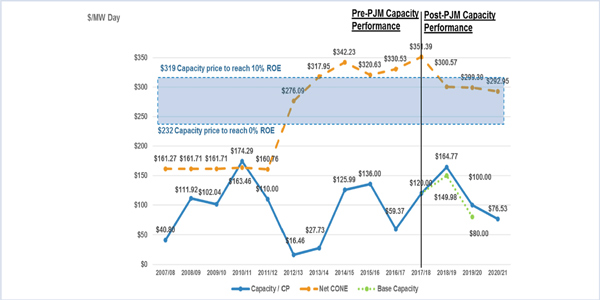By Rich Heidorn Jr.
PJM’s proposed alternative to the Department of Energy’s proposed coal and nuclear price supports came under fire last week, as market monitors, regulators and other RTOs joined PJM Independent Market Monitor Joe Bowring in opposition.
PJM was harshly critical of the DOE Notice of Proposed Rulemaking, which would provide cost-of-service payments for coal and nuclear plants with at least 90 days of on-site fuel supply (RM18-1). Coal and nuclear generation is responsible for more than 50% of PJM’s winter fuel mix, more than any other region in the U.S., excluding VACAR South.
Instead, the RTO called on FERC to order it and other RTOs to file price formation rule changes within 180 days. It has proposed that inflexible generators be allowed to set LMPs. CEO Andy Ott says that by increasing energy prices and creating a steeper supply curve, the change would reduce uplift and increase incentives for following dispatch instructions. (See Critics Slam PJM’s NOPR Alternative as ‘Windfall’.)
At a conference in Camp Hill, Pa., on Wednesday, Bowring rejected Ott’s premise. “Clearly the supply curve is not too flat in PJM,” Bowring said. “PJM has been ensuring the reliability of the grid for the last almost 90 years and it continues to do so. The grid is reliable and resilient, although resilience remains to be defined.”
In reply comments last week, Bowring faulted the proposal on both substance and process, saying the RTO’s 180-day timeline “would unnecessarily truncate the PJM stakeholder process.”

Place | © RTO Insider
Pennsylvania Public Utility Commission Vice Chairman Andrew Place was also critical, saying PJM’s “fast-track proposal for consideration of reforms to marginal cost and shortage pricing are inconsistent with its comments which document the sufficiency of PJM’s reliability.”
“Appropriate and cost-effective reliability and resiliency requirements can be developed through market-based mechanisms, rather than discriminatory, cost-based mechanisms,” Place said.
Robert Howatt, executive director of the Delaware Public Service Commission, joined with environmentalists, industrial customers and others in also opposing the PJM plan. “PJM’s request for a near-term directive to file a proposal it has not fully revealed to its stakeholders, and which has not received the appropriate (let alone any) vetting, inappropriately subverts the stakeholder process,” the group said.
ISO-NE, NYISO Seek Distance from PJM
Both ISO-NE and NYISO sought to distance themselves from PJM’s proposal.
“The region has already invested significant work in implementing major market improvements, including energy market offer-flexibility enhancements, sub-hourly settlements and Pay-for-Performance,” ISO-NE said.
NYISO said it “takes no position on PJM’s proposed reforms at this time other than to emphasize that they are not applicable to New York. Similarly, the NYISO takes no position on the question of whether the commission should initiate Section 206 proceedings in PJM, other than to note that doing so in PJM does not mean it needs to be done in New York. … Consequently, if the commission decides to initiate a Section 206 proceeding to consider PJM’s reforms, it should be a PJM-specific proceeding.”
Other Monitors Also Critical
The CAISO Department of Market Monitoring and Potomac Economics, which monitors MISO, ISO-NE, NYISO and ERCOT, also expressed opposition.
CAISO’s DMM did not submit initial comments on the DOE NOPR because it does not include CAISO, which lacks a centralized capacity market. But it said it was concerned PJM’s proposal could apply to CAISO because it would make changes to spot markets. “If applied to CAISO, the pricing proposed by PJM would undermine CAISO’s spot markets,” the department said. “PJM’s proposal is actually an administrative pricing rule that moves away from efficient spot market pricing.”
Potomac Economics said PJM’s proposal “will be highly inefficient and destructive to existing energy markets in the Eastern Interconnection.”
P3 Group Supports PJM Plan
PJM wasn’t completely lacking for allies. The PJM Power Providers Group (P3) said it “supports the framework that PJM [has] presented to resolve the shortcomings.”

FirstEnergy contends PJM’s Capacity Performance rules haven’t raised prices enough to properly compensate “baseload” generation. | FirstEnergy
But coal interests said it is too little, too late. FirstEnergy said PJM’s proposal is “nothing more than an argument for delay and will not lead to a remedy for current unlawful rates any time soon.”
“While PJM has not yet determined how much customers will have to pay under this construct and how much power plants would be paid, it almost certainly is not enough help to assure that power plants with resilience benefits through on-site fuel will remain in the market,” said the American Coalition for Clean Coal Electricity and the National Mining Association in a joint filing.
Michael Kuser contributed to this article.




